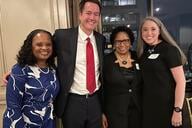You have /5 articles left.
Sign up for a free account or log in.
The recent college admissions bribery scandals have led to both shock and increased interest in admissions practices among the public. Universities and colleges who proclaim visions of fairness, diversity and merit in their admissions processes were caught on the grift, and folks love a hypocritical scandal of epic proportions.
Part of this scandal involved the use of photoshopped images to portray prospective students participating in sports in which they had little or no prior experience, with the goal of deceiving admissions officers so that those students would receive preferential or reserved enrollment slots. This practice of digitally altering images did not begin with the bribery scandal -- or with higher education.
Using software such as Photoshop to create depictions of alternate realities and images has been technically possible and used by companies for decades, but marketing departments and graphic design firms rarely question the morality of these practices. Many versions of this design work are benign -- placing a product against a colored background or using a green screen to create a film set -- and have been accepted as fictional portrayals of a scene or mood, often saving significant time and money for creative endeavors. However, the technical capabilities of Photoshop have made abuses possible and relatively easy to create.
Long before parents' representatives were using Photoshop to give their students an unfair admissions advantage, universities were using the software to portray diversity that did not appear in original photos. We in higher education marketing should not be surprised that this has come back to haunt us.
In February, 2019, it was reported that York College of Pennsylvania had altered an image for a billboard advertisement by replacing the faces of two white students with an African American and (seemingly) Muslim student who was wearing a head covering. After the original unaltered photo was leaked, the comparison received negative attention on social media, and a local station picked up the story.
Dating back further, in 2000, the University of Wisconsin at Madison was one of the first to receive negative press for pasting the face of a black student onto the cover of their application booklet. In that case, the student himself, Diallo Shabazz, discovered it and pointed out that he had never been to a football game at the university, as depicted on the cover.
Consistently, universities overstate their diversity profiles in images on marketing materials. According to a study from 2013, institutions are regularly displaying more black students on marketing materials than they actually have in their student bodies, averaging about 15.1 percent representation in their materials, with only about 7.4 percent in student bodies. Asian student groups are also overrepresented. In a strange twist, Latinx and "other non-white" students are underrepresented, though not by the same amount that black students are used.
And, "used" is exactly the correct turn of phrase in this case, as it becomes clear that the color of black students' bodies is being commoditized as a stand-in for "diversity" in these materials. Doing as they've been taught and instructed, marketing departments have endeavored to create images of diversity to help encourage enrollments, both from students of color (communicating "you'll fit in here") and from diversity-conscious white students.
Enrollment and marketing professionals in higher education will argue that admissions targets cannot be met without utilizing images that display aspirational student compositions. High-level administrators have noted that while the photoshopped images might not be specifically accurate, they did represent an image of the student body that was in the spirit of diversity goals, and that the photoshopped faces were of actual students at their institutions.
Marketing professionals at those organizations also stated that they were working quickly under deadlines to put together photoshoots and materials, and encountered those who were not willing to allow the original, primarily white student photos to go to press.
One of the defining characteristics of Generation Z is their ability to detect what's real and what's contrived. This practice of misrepresenting diversity and failing to display authenticity is not lost on students who are enrolling at higher education institutions. One of the hallmarks of successful marketing and public relations is a gravity towards authenticity and genuineness (see Apple, Patagonia, Ben & Jerry's), a practice that can be difficult for sprawling organizations that serve many constituencies, such as universities.
For students of color, in particular, this authenticity can be proven or broken through marketing materials and subsequent experiences at institutions. Students can tell when a marketing message does not communicate reality -- when a box is being checked in the name of diversity. Marketing professionals and departments should be well-versed in diversity training, sensitivity and subconscious bias, especially in light of their creation of public images that tell stories of institutional growth and awareness. At their core, higher education marketing departments have a responsibility to tell the stories of their students with thoughtfulness, conscience and sincerity. There's also an opportunity to amplify diverse stories, intensifying validity and agency with student groups whose communities and places have been denied.
Photoshopped images, scandals and artificial portrayal of diversity are symptoms of a greater ill -- too many university and college administrators and staffs lack training and preparation for the nuances of working in a diversity-aware world of students. And those students, in their wisdom, know the difference between showing a student of color on a brochure and truly representing diversity in all its forms: color, gender, age, ability, ideas and so much more, because that's the world they've grown up in from the moment they were born. Frequently in the articles referenced above, a student recognized the problem before an administrator, and, to paraphrase, their comments amounted to: "just find a student gathering on campus and point the camera in any direction if you want to show diversity."
Higher education marketers must be connected and influenced by their campuses and the students in them. We can and must do a better job of marketing authenticity.
Nathan Willers has been in higher education and nonprofit marketing for more than 10 years. He's currently at the University of Denver, where he's on staff and enrolled as a doctoral student.




